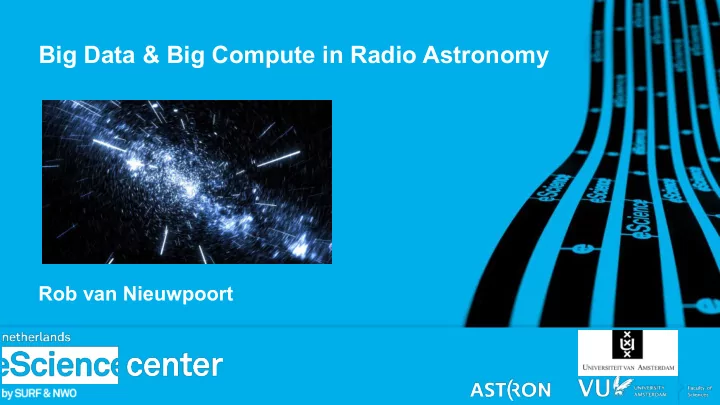

Big Data & Big Compute in Radio Astronomy Rob van Nieuwpoort
Two simultaneous disruptive technologies • Radio Telescopes – New sensor types – Distributed sensor networks – Scale increase – Software telescopes • Computer architecture – Hitting the memory wall – Accelerators
Two simultaneous disruptive technologies • Radio Telescopes – New sensor types – Distributed sensor networks – Scale increase – Software telescopes • Computer architecture – Hitting the memory wall – Accelerators
Next-Generation Telescopes: Apertif Image courtesy Joeri van Leeuwen, ASTRON
LOFAR low-band antennas
LOFAR high-band antennas
Station (150m)
2x3 km
LOFAR • Largest radio telescope in the world • ~100.000 omni-directional antennas • 10 terabit/s, 200 gigabit/s to supercomputer (AMS-IX = 2-3 terabit/s) • Hundreds of teraFLOPS • 10 – 250 MHz • 100x more sensitive [ John Romein et al, PPoPP, 2014 ]
Imaging pipeline (LOFAR) Real-time Offline Source Calibration Gridding finder Light RFI mitigation paths to Antenna correlator Flag catalog visibilities visibilities Mask
[ Chris Broekema et al, Journal of Instrumentation, 2015 ]
1.3 petabit/s 16 terabit/s raw data rate raw data rate [ Chris Broekema et al, Journal of Instrumentation, 2015 ]
Imaging pipeline (LOFAR) Real-time Offline Source Calibration Gridding finder Light RFI mitigation paths to Antenna correlator Flag catalog visibilities visibilities Mask
Imaging pipeline: scaling up to SKA Real-time Offline Source Calibration Gridding finder Light RFI mitigation paths to Antenna correlator catalog visibilities visibilities visibilities
Meanwhile, in computer science… Disruptive changes in architectures
Potential of accelerators • Example: NVIDIA K80 GPU (2014) • Compared to modern CPU (Intel Haswell, 2014) – 28 times faster at 8 times less power per operation – 3.5 times less memory bandwidth per operation – 105 times less bandwidth per operation including PCI-e • Compared to BG/p supercomputer – 642 times faster at 51 times less power per operation – 18 times less memory bandwidth per operation – 546 times less bandwidth per operation including PCI-e • Legacy codes and algorithms are inefficient • Need different programming methodology and programming models, algorithms, optimizations • Can we build large-scale scientific instruments with accelerators?
Our Strategy for flexibility, portability • Investigate algorithms • OpenCL: platform portability • Observation type and parameters only known at run time – E.g. # frequency channels, # receivers, longest baseline, filter quality, observation type • Use runtime compilation and auto-tuning – Map specific problem instance efficiently to hardware – Auto tune platform-specific parameters • Portability across different instruments, observations, platforms, time!
Science Case Pulsar Searching
Searching for Pulsars • Rapidly rotating neutron stars – Discovered in 1967; ~2500 are known – Large mass, precise period, highly magnetized Movie courtesy ESO – Most neutron stars would be otherwise undetectable with current telescopes • “Lab in the sky” – Conditions far beyond laboratories on Earth – Investigate interstellar medium, gravitational waves, general relativity – Low-frequency spectra, pulse morphologies, pulse energy distributions – Physics of the super-dense superfluid present in the neutron star core Alessio Sclocco , Rob van Nieuwpoort, Henri Bal, Joeri van Leeuwen, Jason Hessels, Marco de Vos [ A. Sclocco et al, IEEE eScience, 2015 ]
period Pulsar Searching Pipeline • Three unknowns: – Location: create many beams on the sky [ Alessio Sclocco et al, IPDPS, 2012 ] – Dispersion: focusing the camera [ Alessio Sclocco et al, IPDPS, 2012 ] dispersion – Period • Brute force search across all parameters • Everything is trivially parallel (or is it?) • Complication: Radio Frequency Interference (RFI) [ Rob van Nieuwpoort et al: Exascale Astronomy, 2014 ]
An example of real time challenges Auto-tuning: Dedispersion
Dedispersion [ A. Sclocco et al, IPDPS 2014 ] [ A. Sclocco et al, Astronomy & Computing, 2016 ]
Auto-tuned performance Apertif scenario LOFAR scenario
Auto-tuning platform parameters Work-items per work-group 1024 512 256 Apertif scenario
Histogram: Auto-Tuning Dedispersion for Apertif
Speedup over best possible fixed configuration Apertif scenario
An example of real time challenges Changing algorithms: Period search
Period Search: Folding • Traditional offline approach: FFT • Big Data requires change in algorithm: must be real time & streaming … Stream of samples 0 1 2 3 4 5 6 7 8 9 10 11 12 13 14 15 0 1 2 3 4 5 6 7 Period 8: + 8 9 10 11 12 13 14 15 0 1 2 3 + 4 5 6 7 Period 4: + 8 9 10 11 + 12 13 14 15 [ A. Sclocco et al, IEEE eScience, 2015 ]
Optimizing Folding • Build a tree of periods to maximize reuse • Data reuse: walk the paths from leafs to root
Pulsar pipeline Performance Breakdown LOFAR Apertif Apertif SKA 1 LOFAR Apertif LOFAR SKA 1 period search dedispersion I/O K20 HD7970 Xeon Phi
Pulsar pipeline Apertif and LOFAR: real data SKA1: simulated data Speedup over CPU, 2048x2048 case Power saving over CPU, 2048x2048 case Apertif SKA 1 SKA 1 Apertif LOFAR Apertif Apertif SKA 1 SKA 1 LOFAR Apertif LOFAR LOFAR Apertif LOFAR LOFAR AMD Intel AMD NVIDIA Intel NVIDIA HD7970 Xeon Phi HD7970 K20 Xeon Phi K20 SKA1 baseline design, pulsar survey: 2,222 beams; 16,113 DMs; 2,048 periods. Total number of GPUs needed: 140,000. This requires 30 MW. SKA2 should be 100x larger, in the 2023-2030 timeframe.
Pulsar B1919+21 in the Fox nebula (Vulpecula). Pulse profile created with real-time RFI mitigation and folding, LOFAR. Background picture courtesy European Southern Observatory.
Conclusions: size does matter! • Big Data changes everything – Offline versus streaming, best hardware architecture, algorithms, optimizations – Need modular architectures that allow us to easily plug- in accelerators, FPGAs, ASICs, … – Auto-tuning and runtime compilation: powerful mechanisms for performance and portability • eScience approach works! – Need domain expert for deep understanding & choice of algorithms – Need computer scientists for investigating efficient solutions – LOFAR has already discovered more than 25 new pulsars! • Astronomy is a driving force for HPC, Big Data, eScience – Techniques are generic, already applied in image processing, climate, digital forensics
Recommend
More recommend